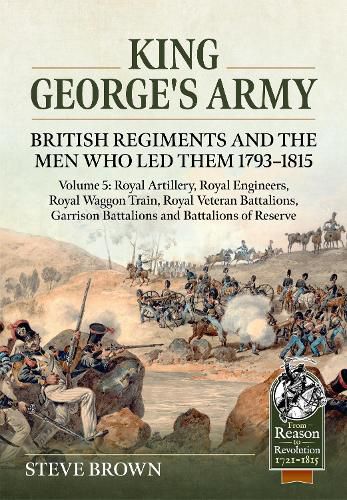Readings Newsletter
Become a Readings Member to make your shopping experience even easier.
Sign in or sign up for free!
You’re not far away from qualifying for FREE standard shipping within Australia
You’ve qualified for FREE standard shipping within Australia
The cart is loading…






King George's Army: British Regiments and the Men who Led Them 1793-1815 will contain five volumes, with coverage given to army administration and cavalry regiments (Volume 1), infantry regiments (Volumes 2, 3 and 4), and ordnance (Volume 5). It is the natural extension to the web series of the same name by the same author which existed on the Napoleon Series from 2009 until 2019, but greatly expanded to include substantially more biographical information as well as biographies of leading political figures concerned with the administration of the army as well as commanders in chief of all major commands. Volume 5 covers in great detail the ordnance (the Royal Artillery and Royal Engineers) within the army of King George the Third for the period of the Great War with France; and the men who commanded them. Unit data provided includes short-form lineages, service locations and dispositions for the era, tables of authorised establishments, demographics of the field officer cohorts and of the men. But the book is essentially concerned with the field officers, the lieutenant colonels and majors who commanded the units and Volume 5 alone contains around 800 mini-biographies of men who exercised such command, including their dates of birth and death, parentage, education, career (including political), awards and honours, and places of residence. AUTHOR: Author Steve Brown has an interest in Napoleonic studies dating back to his teenage years; he has amassed a collection of about 2,000 volumes on the subject, with a particular focus on the British Army. Since 2009 has been a frequent contributor to the Napoleon Series, his main contribution being the highly-regarded British Regiments and the Men Who Led Them series, as well as a book reviewer. In 2015 he presented at the Waterloo 200 conference of the Royal Australian Historical Society.
$9.00 standard shipping within Australia
FREE standard shipping within Australia for orders over $100.00
Express & International shipping calculated at checkout
King George's Army: British Regiments and the Men who Led Them 1793-1815 will contain five volumes, with coverage given to army administration and cavalry regiments (Volume 1), infantry regiments (Volumes 2, 3 and 4), and ordnance (Volume 5). It is the natural extension to the web series of the same name by the same author which existed on the Napoleon Series from 2009 until 2019, but greatly expanded to include substantially more biographical information as well as biographies of leading political figures concerned with the administration of the army as well as commanders in chief of all major commands. Volume 5 covers in great detail the ordnance (the Royal Artillery and Royal Engineers) within the army of King George the Third for the period of the Great War with France; and the men who commanded them. Unit data provided includes short-form lineages, service locations and dispositions for the era, tables of authorised establishments, demographics of the field officer cohorts and of the men. But the book is essentially concerned with the field officers, the lieutenant colonels and majors who commanded the units and Volume 5 alone contains around 800 mini-biographies of men who exercised such command, including their dates of birth and death, parentage, education, career (including political), awards and honours, and places of residence. AUTHOR: Author Steve Brown has an interest in Napoleonic studies dating back to his teenage years; he has amassed a collection of about 2,000 volumes on the subject, with a particular focus on the British Army. Since 2009 has been a frequent contributor to the Napoleon Series, his main contribution being the highly-regarded British Regiments and the Men Who Led Them series, as well as a book reviewer. In 2015 he presented at the Waterloo 200 conference of the Royal Australian Historical Society.